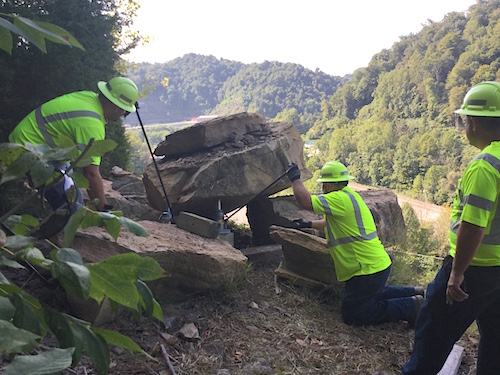Huge boulders removed from KY 80 in Floyd County by state workers, for $500
FLOYD COUNTY – Friday, August 30, 2018 – Two rocks towered precariously over the eastbound lanes of KY 80 near Martin. Highway District 12 engineers knew they had to come down. But how? An experienced contractor estimated the cost to be at least $120,000. That’s when the men of Minnie Maintenance stepped up.

On Friday, August 23, Eddie Combs and Josh Compton, highway technician assistants, with engineers Matthew Moore and Darold Slone, rode a side by side to the top of the cut, then climbed the hill on foot. They carried 45-pound hydraulic bottle jacks, wood blocks for cribbing, a mattock, a shovel, a two-way radio, and their determination to get the job done.
Three hours later, two large sandstone rocks shattered and fell.
The position of these boulders was caused by a rockfall earlier in the year. One was overhanging the bench, held in place by a much larger rock, estimated to weigh 26 tons. Combs and Compton devised a plan to lift and shift the larger rock, which would take the weight off the overhanging rock, allowing it to fall.
The four-man team scoped out the situation in advance and packed their equipment to the rock shelf the day before. Combs had relevant experience working with bottle jacks as a coal miner. Compton showed interest and initiative months ago when he volunteered to find a way up the mountain and took the first pictures of the situation.

Moore calculated the weight of the two boulders by measuring and applying mathematical formulas. The jacks were rated for 30 tons each. Moore estimated the combined weight of the rocks at 39 tons. They bought two jacks.
“We were on Plan E by the time it worked,” Compton said.
“About mid-alphabet,” agreed Combs.
“The first two plans failed right off the bat. We had plenty of room to work, but we didn’t have good anchor points to push from,” Compton explained.
“We had to crank the jacks, move ’em, crib it, readjust, crank some more,” Combs said. “After about thirty to forty-five minutes, your arms get tired.”
That’s where Moore and Slone pitched in. Both men agreed that Matt and Darold worked as hard as they did. “Some higher-ups wouldn’t have done that,” Combs said. “We got to know them better, and that means something.”
Three hours after they started, Combs was frustrated. But committed. The rocks were nearly straight up and down; the jacks couldn’t catch a bite. They were now so close that there was no turning back. “Either those rocks were coming off that hill or we wasn’t coming down,” Combs said. Compton agreed. “No way were we leaving.”
“One rock defied gravity. I walked off a little ways and said, ‘Lord, I don’t know what else to do. You’re gonna have to help us here,’” Combs admitted. “And it was like he directed my attention to a corner where the rock was just barely above the ground. ‘Put your jack over there.’ So I asked Josh what he thought. I asked Darold what he thought. We put a jack at that corner, and that was all it took. I’m gonna tell you straight up, I don’t take no credit for it. The Lord just used us. He let us work at it a little bit, but he got the rocks off that hill.”
The rocks broke apart, tumbling to the second bench above the roadway, fragments that now pose no danger to traffic.

The next work day, Combs and Compton were back on the ground with the rest of the Minnie crew, cleaning the ditchline on Abner Mountain. What did they get from their experience? “We got a lot of attaboys,” Compton said. “But those rocks were dangerous. So there’s that. Plus, we saved the state a hundred and twenty thousand dollars. I’d say that’s pretty good for one day’s work.”
Indeed. The total cost was less than $500 for tools and supplies. The labor cost for the entire crew would have been paid regardless of what job they worked that day. “When I retire,” said Darold Slone, “this project will be one of the highlights of my career, for what we accomplished with our people thinking outside the box. They worked hard and they did it the right way. I’m as proud of this project as anything I’ve ever worked on.”
Matt Moore pointed out that “Josh and Eddie had a ‘can do’ attitude. They both were very confident and capable. Everyone looked out for each other, and I definitely felt safe the whole time. But I have to say, it was a sight watching Josh carry both 45-pound jacks down the hill at the same time.”
Combs and Compton were quick to praise the rest of their crew for taking care of traffic control on the highway so they didn’t have to worry about what might happen when the rocks did fall. “Our job might have been harder physically,” Combs said, “but their job was harder mentally. They had to deal with a lot of mad people.”
Adam Brown coordinated things on the ground. The crew had to block the road and turn traffic on either end through Martin. People weren’t happy, but they didn’t understand the danger they were being forced to avoid. Grady Allen, Brandon Akers, Phillip Anderson, Brady Conn Jr., Todd Crisp, Jared Hensley, David Kilburn, Brian Lafferty, Lee Little, Nicholas Mullins, Jeremy Slone, and Kelly Watts took turns flagging, used their vehicles to block the road, and cleaned up the mess afterwards. “Mary was there,” Combs said, referring to Mary Westfall-Holbrook, the district’s chief engineer. “Actually, it was her idea for us to use bottle jacks to do the job,” a decision that proved brilliant from both aspects — financial savings and using the district’s crew to do the work.
Combs said, “I’d do any job with those two (Moore and Slone). They let us pretty much decide what to do. They never made us feel nervous. And they were just as dirty as we were when it was all over. You can tell Darold walks a lot; he hustled up that hill when we were finished. I told ’em I’d be there directly, just save an Ale 8 One for me.”
Compton’s assessment: “I respect them boys now more than I ever did. I’d do it all over again with them. It was an adventure.”













![Foothills-Bundle] Foothills-Bundle](https://thelevisalazer.com/wp-content/uploads/2020/05/Foothills-Bundle-422x74.jpg)





